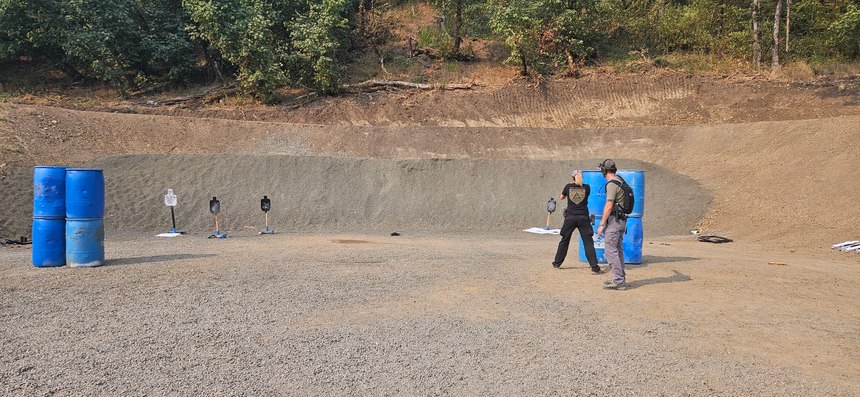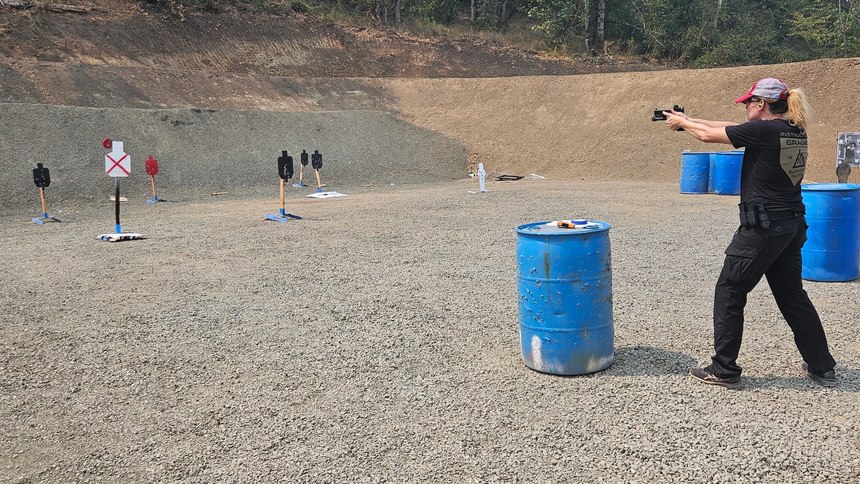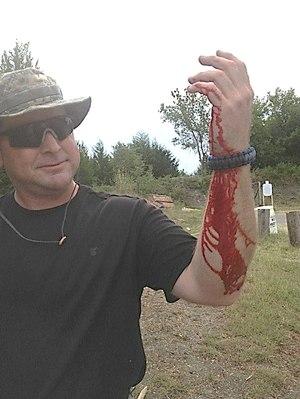
By Todd Fletcher for Police1.Com
Combative Firearms Training
Unpredictable bullet spatter can be dangerous for everyone on the range
Most officers enjoy the satisfying ring of a successful hit on a steel target. Coupled with the visual feedback of seeing the steel plate move and the round splashing into the soft ground, it’s instant feedback indicating a job well done.
Unfortunately, most of us have never been trained to use steel targets safely. If you are getting little pieces of shrapnel sent back up range, it’s a sign something is wrong with the equipment or range setup. Unpredictable bullet spatter can be dangerous for everyone on the range. But with a little bit of knowledge, we can set up steel targets safely and make our training more effective.
SAFER TRAINING
Everyone knows that eye and ear protection should always be worn during firearms training. When we train with steel targets, quality eye protection is even more critical. Our eye protection should fit snugly at the top, sides, and bottom of the glasses to prevent debris from entering behind the lenses.
The amount of bullet spatter created from the bullet striking the steel plate depends on several factors including the angle of deflection, target hardness, bullet design, target placement, and target condition. The angle of deflection is the area located under and around the target where fragmented bullets impact. The more the target face angles forward, the more the bullet spatter will be deflected behind the target.
A simple way to determine your spatter zone is to shoot your target with a paper or cardboard target on the ground. The bullet spatter will leave holes in the paper showing you where the spatter zone is located. In addition, using cardboard around the base and stand of steel targets is a quick and easy way to reduce the amount of bullet spatter that goes up range. This may be critical if the ground is hard preventing the bullet spatter from being slowed down by soft dirt.
Bullet design is another important part of steel target safety. Frangible ammunition is the best choice because it leaves little to no bullet spatter. Unfortunately, frangible ammunition is expensive compared to jacketed training ammunition. Aside from frangible ammunition, it’s best to use high-velocity non-bonded ammunition to create a predictable spatter zone. Bonded duty ammunition should never be used with steel targets.

MORE EFFECTIVE TRAINING
Steel targets are a great training tool because they don’t need to be replaced frequently like with paper and cardboard targets. A little bit of spray paint and you’re good to go saving time that can be used for more training.
Officers can gain confidence in their ability to engage targets quickly and accurately by developing skills at the subconscious level of awareness. The subconscious mind can learn to reflexively control the shooting process due to instantaneous audible and verbal feedback when the target rings, falls, retracts, or drops providing assurance of accuracy. This repetition and feedback loop compresses combative marksmanship into reaction-time components achieving a balance between speed and accuracy.
By selecting targets of assorted sizes and shapes, officers develop an understanding of when they can go faster and when they need to slow down. Changing the pace of shooting is a challenge for all shooters, especially when moving from larger targets to smaller targets requiring precise shot placement. When officers recognize the need to slow down to make good hits under time duress in training, it can help train their brains to recognize when they need to slow down under the stress and time duress of a lethal encounter.
CHOOSING STEEL TARGETS
When purchasing steel targets, quality manufacturers use steel with a Brinell hardness rating of at least 500. If you buy from a reputable manufacturer, you will get good steel. If you think you can head down to your local steel supply store, buy high-quality AR500 steel off the shelf, and weld targets together in your garage, you’re going to be disappointed in the durability of the targets and create potentially unsafe training conditions.
Quality steel targets can take years of hard use on the range when properly maintained and used correctly. Make sure you match your steel targets with their intended use. If you’re going to use steel targets for handgun training only, look for 3/8″ AR500 steel targets. These targets will provide sufficient strength, hardness, impact resistance, and durability for years of hard use from duty-caliber handguns.
However, if your plans include rifle training, I recommend buying 1/2″ AR500 or 1/2″ AR550 steel targets. These can take thousands of rounds and will handle the heavy workload. To avoid pitting the targets, make sure the bullet velocity at the target does not exceed 2,800 fps. I like to see bullet velocities down around 2,700 fps as an additional safety buffer. The problem with rifle-rated steel is that it’s more expensive and significantly heavier to move around.

know when they can speed it up and when they need to slow it down. (Photo/Todd Fletcher)
TARGET PLACEMENT
Placing steel targets on soft dirt or grass is important to keeping a predictable spatter zone. Gravel, asphalt, concrete, or any other hard surface can lead to bullet spatter being sent up range. Most of the time, bullet spatter is just annoying, but it has also been known to require a trip to the hospital to have bullet fragments dug out due to improper target placement or surface preparation.
Bullet spatter can come off anything around the target, so keep other targets and target stands outside the spatter zone. Additional steel targets should not be placed in a line without a barrier between them. Instead, stagger targets to keep them out of the spatter zone. Once again, cardboard placed over the base of the stands is a simple and effective way to reduce spatter.
For handgun training, I recommend 10 yards as the minimum distance between the shooter and the target. This keeps the shooter outside the spatter zone and decreases the likelihood of safety problems. As for rifle training, unless frangible ammunition is used, I recommend keeping the targets at 100 yards.

can avoid these types of injuries. (Photo/Todd Fletcher)
TARGET MAINTENANCE
Quality steel targets are durable and can last a long time with some simple care and maintenance. Prior to training, inspect steel plates for cracking, pitting, or other signs of damage. Steel targets that are smooth and flat provide a predictable spatter pattern.
Once the training day is complete, keeping steel targets clean and free of corrosion is key to their longevity. One way to do this is to coat a rag with oil and run it over the steel to prevent corrosion. This works well for steel that is frequently used and left outside. If the targets are stored inside, no one wants to get covered in oil when moving them, so using quality spray paint with a rust inhibitor can accomplish the same result without the mess.
Steel targets can make training fun and interesting, but they are also an effective way to train the balance between speed and accuracy. They eliminate the need to tape holes and post new paper targets, and they aren’t affected by adverse weather conditions. So, get to the range, have some fun while developing your skills, and make the steel targets sing!
About the author
Todd Fletcher is the owner and lead instructor for Combative Firearms Training, LLC providing training for law enforcement firearms instructors from coast to coast. He has over 25 years of training experience as a firearms and defensive tactics instructor. He retired after more than 25 years as a full-time police officer and over 31 years of law enforcement experience.
Todd is a member of the International Defensive Pistol Association (IDPA) and the United States Practical Shooting Association (USPSA). He is a member of the International Law Enforcement Educators and Trainers Association (ILEETA), and was selected as the 2022 ILEETA Trainer-of-the-Year. He is also a member of the International Association of Law Enforcement Firearms Instructors (IALEFI) and won the 2023 IALEFI Top Gun Award. He can be reached at Todd@CombativeFirearms.com.







